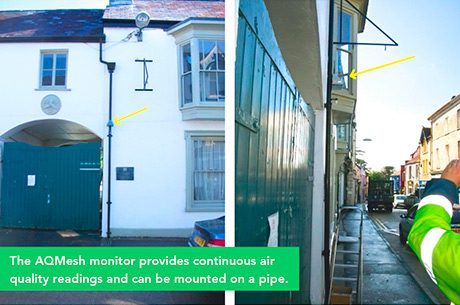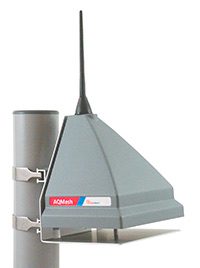
SITUATED in the south west of Wales, in a largely rural area bordering the Brecon Beacons, Carmarthenshire’s air quality is predominantly good.
However, there are areas of concern where major roads pass through some of the County’s larger towns, including Llanelli, Carmarthen and Llandeilo, where air quality is dominated by the effects of road traffic. The County Council is therefore testing new monitoring technologies so that it will be better able to track the effects of improvement measures.
Carmarthenshire County Council operates a network of passive diffusion tubes as part of its commitment to Local Air Quality Management under Part IV of the Environment Act 1995. However, in 2013, Air Monitors supplied the Council with a new type of air quality monitor, ‘AQMesh’, that is able to provide continuous air quality readings for a range of important parameters. This new technology is small, wireless, lightweight and battery powered, which means that it can be quickly and simply mounted in almost any location.
The Council’s monitoring programme has identified nitrogen dioxide (NO2) from traffic emissions, mostly diesel vehicles, as the pollutant of greatest concern. A number of locations in the centre of Llandeilo have been shown to be in breach of European air quality standards, so an Air Quality Management Area (AQMA) has been established in the town. Whilst NO2 levels are not sufficiently high to cause immediate health effects, the current levels could cause adverse health effects over the long term, particularly in people suffering from respiratory conditions such as asthma and chronic obstructive pulmonary disease.
NO2 reduction by about 25µg/m3 is the main objective of the air quality action plan, but the Council is determined to ensure that all pollutants remain at safe levels, so the ability of the AQMesh to monitor a wide range of parameters (ozone, carbon monoxide, sulphur dioxide, nitrogen monoxide, nitrogen dioxide, temperature, humidity and atmospheric pressure) is a major benefit.
Stephen Hoskin from Air Monitors says: “There are a number of important new features in AQMesh that are fundamentally changing the way that air quality is monitored; firstly, it can be located where air quality matters most – where people are breathing.
“Secondly, in comparison with large reference stations, with only a small drop in levels of accuracy, the cost of monitoring is reduced dramatically, which means that users will be able to measure air quality in more locations, and this will reduce the UK’s current dependence on modelling to ‘guesstimate’ air quality.
“Finally, by providing near real-time data over the internet, useful air quality data can be made available to a much wider audience via smartphones, tablets and computers.”
The AQMesh in Carmarthenshire is being operated by Oliver Matthews, one of the Council’s Environmental Health Practitioners with specific responsibility for air quality. He says: “In the past we have not continuously monitored this range of parameters because doing so would have involved the installation of a large, expensive air quality monitoring station that would have probably required planning permission.

Traditional approaches to continuous monitoring
“These reference stations offer high levels of accuracy, but come with large capital and operational costs, and cannot typically be moved, whereas the AQMesh can be quickly attached to a lamp post or other item of street furniture at a fraction of the cost.
“Alternatively, we could install passive diffusion tubes, one for each parameter of interest, but the disadvantage of this method is that the tubes are left in place for four to five weeks, so we are only provided with an average figure over that time, with no indication of the peaks and troughs that occur. For example, a recent road closure resulted in the diversion of traffic and, with the benefit of AQMesh, we were able to track a significant short-term rise in NO2.”
With the assistance of key stakeholders, the AQMA draft action plan has identified a number of options to improve air quality, and the AQMesh unit has been installed in order to help assess the success or failure of each initiative.
Traffic diversions
Interestingly, the development of the AQMA action plan benefitted from essential gas main works that were required in Llandeilo because this involved the closure of the main trunk road (Rhosmaen Street) for a period of up to three months, which provided an opportunity to identify the effects of traffic diversions on air quality.
Options that are being considered as part of the action plan include improving traffic management and seeking to prevent vehicular ‘stop/start’ and promote a smooth flow of traffic. Typically, these options could include the provision of extra parking outside of the AQMA, the removal of some on-road parking within the AQMA, better parking enforcement, relocation of bus stops, reviewing pedestrian crossings and improvement of bottle necks.
Summarising, Oliver says: “The network of diffusion tubes has enabled us to identify hotspots, and these are the locations at which the AQMesh will be of greatest use because we will be able to study trends and look for the causes of elevated pollution levels at specific times of the day.
“Data from the AQMesh are provided on a website via the ‘Cloud’ so, looking forward, this technology has the potential to make a major difference to air quality improvements and to the transparency and availability of data. For example, it may become possible to integrate air quality monitoring with automatic traffic management.”







